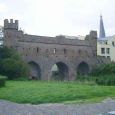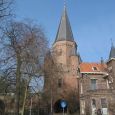Zutphen
Advertisement
By train
Zutphen , where twelve trains per hour leave, is a railway junction. There are two trains per hour to Winterswijk , Hengelo - Oldenzaal , Deventer, Zwolle , Apeldoorn , and four trains per hour to Arnhem - Nijmegen .
By road
Zutphen is situated about ten kilometers south of the A1 , in Deventer, and is a junction of roads: and N826 ( Laren ).
By bus
Within the town are a number of city buses, which operate in the hands of Arriva . Besides city bus lines 80, 83 and 89 also provide local bus such as line 81 (Zutphen - Eefde - Gorssel - Deventer) and line 54 (Zutphen - Eefde - Almen - Laren) public transport, particularly for the northern parts of Zutphen.
Berkelpoort
The Berkelpoort is a water gate and part of the Zutphen wall and situated on the eastern edge of downtown, across the small river Berkel . The gate was built in the 14th century the two settlements on either side of the Berkel connecting.Originally there were two water ports along the city wall around the city formed a fortress. The other water gate, which was located at the current post office was demolished in 1774.In 1888 the Berkelpoort restored by architect PJH Cuypers . Cuypers preserveerde the ruinous state of the port through the top of the walls with a layer of cement covering. In 1951 came a new, more reconstructive restoration.
Drogenapstoren
The Drogenapstoren, originally the Salt Gate called, was built in 1444-1446 as the gate of Zutphen . He has only recently as a gate as he served in 1465 was bricked. Since then he wears the name Drogenapstoren, named after the town musician Tonis Drogenap.Tonis was called Drogenap not really, it was just a nickname. Probably he was so called because he drank quite a lot. Another theory is that he was so called because he was very poor. A nap at that time because a wallet and a dry bowl was an empty wallet. Drogenap lived in Zutphen around 1555 and named the tower itself.Because of its prominent place in the history of Zutphen Drogenap Foundation decided in 1999, a statue for him to set up. While the origin of the statue was the work of sculptor Oscar Rambonnet open to the public, that the genesis followed with great interest.
St. Walburgiskerk
The Saint Walburgiskerk, known locally as Walburg Church is a church of the 's Gravenhof in Zutphen . She is among the top 100 of the Dutch UNESCO monuments .The oldest part of the church dates from the 11th century . The church, at least part of the chapter, in 1105 dedicated to the English saint Walburga or Walburgisstraat, of whom a statue on the kerkerf state. Previously, the church dedicated to St. Peter, but that was repressed by Walburga in the course of the 12th century. The parish church was dedicated to Our Lady. Mary was also the medieval patron. The present church dates largely from the first half of the 13th century , since the 16th century, it has its contemporary appearance. The tower has a height of 76 meters, but 1600 was 117 meters high. This made the tower is taller than the Cathedral of Utrecht .
Winehouse Tower
The 1371-built Tower Winery in Zutphen belonged to the wine merchant guild . The tower is part of the inn "to Peace", which existed before 1371 exists.The building was originally built as an inn and important guests. In 1420 the city bought the building on the important foreign guests. The city decided to build additional windows and alterations, "convenience" (medieval toilets) and a stone staircase access. The house was further used as a courtroom and for meetings of the townspeople. The winery name comes from the room at the inn where they drank wine and had fun together.
Museum Henriette Polak
The Museum Henriette Polak in Zutphen was opened in 1975.The name owes it to one of the founders, the patron Henriette Polak -Schwarz (1893-1974). The artist Joop Sjollema (1900-1990) developed a plan to establish a museum. This led to the foundation Antoinette Henriette, who began to gather a collection of classic modern art. This work was included among others the artist Constant Nieuwenhuis , Kees Maks , Wim Oepts , Kees Verwey , Jan Wiegers and Nicolaas Wijnberg.
Information not available





